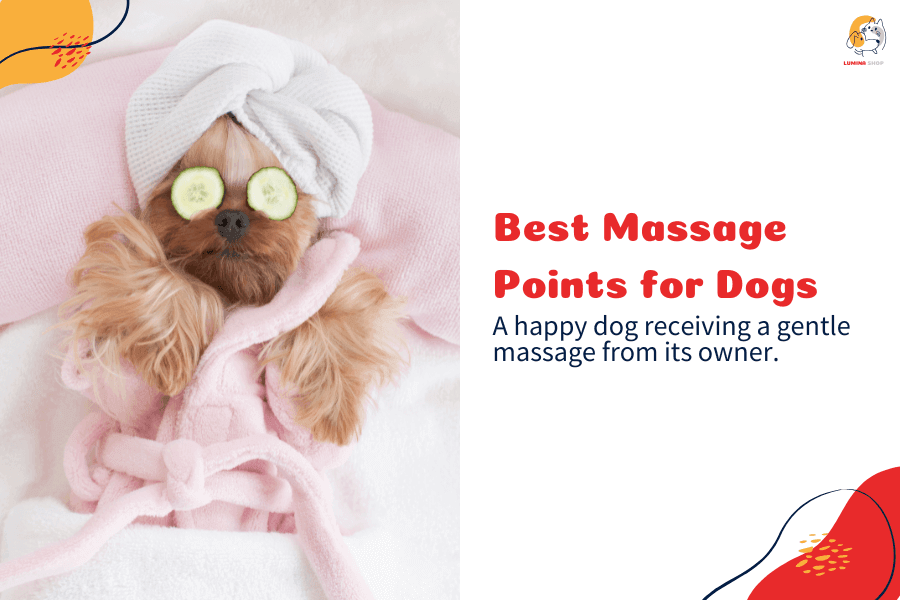
Where Is the Best Point to Massage a Dog?
Massaging your dog isn’t just a way to bond—it’s a powerful tool for reducing stress, easing muscle tension, and promoting relaxation. Just like humans, dogs have specific pressure points that, when massaged correctly, can improve circulation, reduce anxiety, and even relieve pain.
So, where is the best place to massage your dog? In this guide, we’ll explore the top pressure points, their benefits, and easy techniques to give your pup a soothing massage.

1. Why Should You Massage Your Dog?
Dog massage offers several physical and emotional benefits, including:
- Relieving muscle tension and stiffness
- Reducing anxiety and stress
- Improving blood circulation and flexibility
- Aiding digestion and promoting better sleep
- Strengthening your bond with your pet
By focusing on the right massage points, you can make your dog feel more relaxed, comfortable, and happy.
Recommended Products:
Calming Treats for Dogs – Helps dogs relax before or after a massage.

2. Best Massage Points for Dogs
1. The Ears – The Relaxation Point
- Why? Massaging the ears releases endorphins, which help reduce stress and anxiety.
- How? Use your fingertips to gently rub the base of the ears in circular motions. Move upwards toward the tips with light pressure.
2. The Neck and Shoulders – The Tension Release Zone
- Why? Many dogs carry tension in their neck and shoulders, especially active or older dogs.
- How? Apply gentle, slow circular motions along the neck and shoulders. For larger dogs, use the palm of your hand to apply light pressure.
Recommended Products:
Pet Massage Brush – Aids in relaxing muscle tension while brushing.
3. The Chest – The Comfort Zone
- Why? Massaging the chest can calm an anxious dog and promote relaxation.
- How? Use both hands to gently rub and stroke the chest area in small circles.
4. The Back – The Stress Relief Area
- Why? The spine holds a lot of tension, especially in high-energy or working dogs.
- How? Apply gentle strokes down the back, avoiding direct pressure on the spine.
Recommended Products:
Orthopedic Dog Bed – Provides extra support for dogs with back tension.
5. The Legs and Paws – The Circulation Booster
- Why? Massaging the legs and paws improves circulation and relieves joint stiffness.
- How? Gently rub each leg from top to bottom, applying light pressure on the paws and toes.
Recommended Products:
Paw Balm for Dogs – Keeps paws moisturized and healthy after a massage.
6. The Hips – The Mobility Enhancer
- Why? Hip massages can help senior dogs or those prone to hip dysplasia by reducing stiffness.
- How? Use gentle circular motions around the hip area, avoiding direct pressure on the joints.
Recommended Products:
Joint Supplements for Dogs – Supports joint health and mobility.

3. How to Give Your Dog a Relaxing Massage
Follow these simple steps to ensure a calming experience for your pup:
- Choose a quiet space – Ensure your dog is comfortable and relaxed.
- Start with gentle strokes – Begin with slow, light strokes to warm up the muscles.
- Apply light pressure – Use gentle circular motions and adjust pressure based on your dog's comfort.
- Watch your dog’s reactions – If they seem uneasy, reduce pressure or try a different spot.
- Keep sessions short – A 5-10 minute massage is enough to provide relief and relaxation.

4. When to Avoid Massaging Your Dog
While massages are generally safe, avoid them if your dog has:
- Recent injuries or surgeries
- Swelling or open wounds
- Skin infections or irritation
- Pain when touched (Consult a vet first)

Conclusion
The best massage points for dogs include the ears, neck, back, paws, and hips. Regular massages help reduce stress, improve circulation, and ease muscle tension, making them a great addition to your dog’s wellness routine.
To enhance relaxation, try using calming treats, joint supplements, and massage brushes from Lumina Pet Shop.
Give your dog the gift of relaxation—they’ll love you even more for it
